사일런트 스위처 기술과 입력 차단 기능을 결합하여 성능 및 보호 기능을 강화한 부스트 컨버터에 대해 아나로그디바이스(Analog Devices, Inc.)의 마이클 우(Michael Wu) 스태프 애플리케이션 엔지니어가 이야기 한다.
사일런트 스위처 기술·입력 차단 기능으로 부스트 컨버터 혁신
EMI 방출 최소화·높은 효율 제공, 소형 4㎜×4㎜ LQFN 패키지
이 글에서는 작고 강력하면서 노이즈가 적은 모놀리식 동기 부스트 컨버터를 소개한다. 아울러 이 IC의 성능을 향상시키고 다양한 애플리케이션의 요구사항에 맞게 맞춤화 설정이 가능한 여러 기능들을 살펴본다.
■ 단락 보호 기능이 있는 모놀리식 동기 부스트 컨버터
일반적인 부스트 컨버터는 출력에서 단락이 발생할 경우 보호 기능을 거의 또는 전혀 제공하지 못한다. 부스트 컨버터의 자체 토폴로지로 인해, 출력이 접지로 단락되면 입력에서 접지로 직접적인 경로가 생성되며, 그 결과 과도한 전류가 흐르게 되면서 디바이스에 손상을 줄 수 있다.
이와 대조적으로, 이 모놀리식 동기 부스트 컨버터는 단락이 발생할 경우 전류를 모니터링하고 입력을 차단할 수 있는 단락 보호 기능을 갖추고 있어 잠재적인 손상으로부터 디바이스를 보호한다.
LT8342는 40V, 9A 사양의 파워 스위치를 내장하여 최대 출력 전압을 36V까지 생성할 수 있다. 또한 2.8V∼40V의 넓은 입력 전압 범위를 지원하며 VIN ≥ VOUT 조건에서 작동되는 패스스루(PassThru™) 모드 동작을 포함한다. 이 집적회로(IC)는 버스트 모드(Burst Mode®) 동작 시 낮은 VIN 핀 대기 전류(quiescent current)를 가지며, 자체 설정이나 외부 클럭 신호 인가를 통하여 동작 주파수를 3㎒까지 키울 수 있어 외부 부품을 포함한 전체 부품이 차지하는 면적을 줄여준다. 또한 이 디바이스는 사일런트 스위처(Silent Switcher®) 아키텍처를 사용하여 전자기 간섭(EMI) 방출을 최소화하면서 높은 효율을 제공하며 소형 4㎜ × 4㎜ LQFN 패키지로 제공된다.
■ 고성능 24V, 3A 전원 공급
그림 1은 출력 단락 보호 기능이 구현된 24V 부스트 애플리케이션을 보여준다. 이 애플리케이션은 입력 전압이 12V 이상일 때 최대 3A의 부하 전류를 공급할 수 있으며, 15kΩ 저항을 RT 핀과 접지 사이에 연결하면 스위칭 주파수가 2㎒로 설정된다.
▲그림 1. 단락 보호 기능을 지원하는 2㎒, 24V 출력 부스트 컨버터 구성도
SYNC/MODE 핀을 설정함으로써, 이 부스트 컨버터는 애플리케이션의 필요에 따라 버스트 모드(Burst Mode) 또는 펄스 스키핑 모드(pulse-skipping mode)로 동작할 수 있다. 버스트 모드는 경부하 조건에서 더 높은 효율을 제공하며, 펄스 스키핑 모드는 출력 리플을 줄여준다. 그림 2는 24V 출력 전압을 애플리케이션에서 버스트 모드 동작 시(SYNC/MODE=0V) 입력 전압에 따른 효율과 전력 손실을 나타낸다. 경부하 조건에서도 70% 이상의 효율을 제공하며, 20V 입력 전압 공급 시 24V/3A 출력을 95%의 효율로 공급할 수 있다..
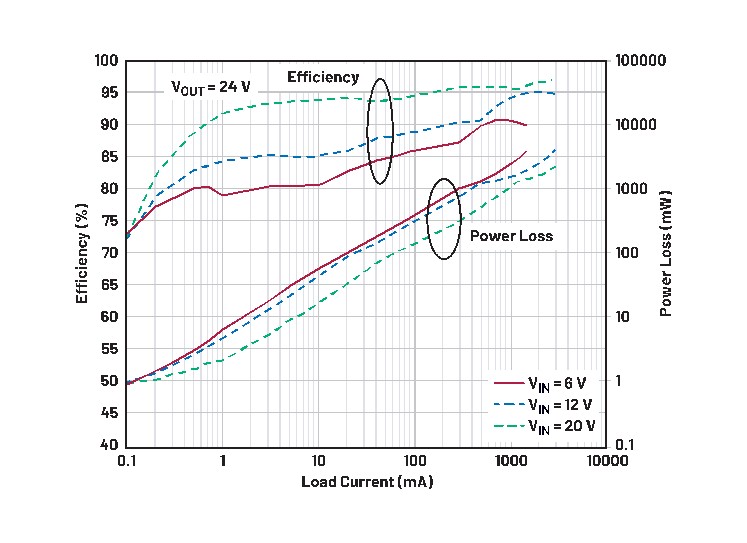
▲그림 2. 버스트 모드 동작 시 효율 및 전력 손실 대비 부하 전류 (SYNC/MODE = 0V)
▲그림 3. 전도 EMI 성능 (CISPR 25 클래스 5 피크)
■ 낮은 IQ 전류
버스트 모드로 작동할 때, LT8342는 출력 전압을 유지하기 위해 작은 단일 전류 펄스를 공급한 후 절전 모드(sleep period)로 들어간다. 이 절전 모드 동안, VIN 핀으로 공급되는 전류는 단락 보호가 설정되어 있지 않을 경우에는 9㎂이며, 단락 보호가 설정된 경우에는 28㎂이. 부하가 작아질수록, 이 디바이스는 절전 모드에서 더 오랜 시간 동안 머무르므로 효율이 향상된다. 그 밖에 IC가 셧다운 모드에 있을 때에는 단 350nA의 입력 대기 전류만 소비한다.
■ CISPR 25 클래스 5 방사 결과4
LT8342는 사일런트 스위처 아키텍처와 함께 추가 기능으로 확산 스펙트럼 주파수 변조(spread spectrum frequency modulation, SSFM) 모드를 제공함으로써, EMI 방출을 더욱 최소화한다. SYNC/MODE 핀을 설정하여 SSFM을 활성화하면, 내부 오실레이터 주파수는 설정된 값과 약 13% 더 높은 값 사이에서 변화한다. CISPR 25 클래스 5 표준에 따른 전도 및 방사 EMI 결과는 각각 그림 3과 4에서 볼 수 있다. 또한 SSFM은 버스트 모드 또는 펄스 스키핑 모드에서도 활성화될 수 있어 낮은 EMI와 높은 효율을 모두 제공한다.
▲그림 4. 방사 EMI 성능 (CISPR 25 클래스 5 피크)
■ 단락 회로 보호
LT8342는 출력 단락 보호 기능을 갖추고 있어 단락 발생 시 손상을 방지한다. 컨버터 입력과 직렬로 연결된 외부 감지 저항과 N-채널 FET가 전류를 모니터링하고, 필요시 입력을 차단한다. 감지 저항을 통해 흐르는 전류가 내부 비교기의 기준값보다 커지게 된다면, 이 IC는 GATE 핀의 전압을 접지로 낮추어 외부 FET를 끄고 단락으로 발생한 출력 전류를 제한한다. 그림 5 및 6의 파형은 출력에서 단락이 발생했을 때, 이 IC의 일반적인 반응을 보여준다.
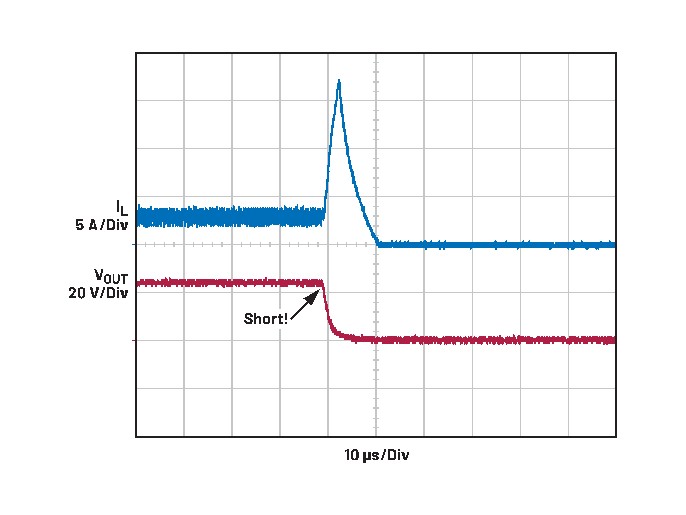
▲그림 5. 출력 단락 보호
외부 FET가 다시 켜질 때까지 내부 히컵 타이머(hiccup timer)가 40ms 동안 카운트한다. 단락이 지속되면, 전류 감지가 트리거될 때 입력 차단이 다시 활성화된다.
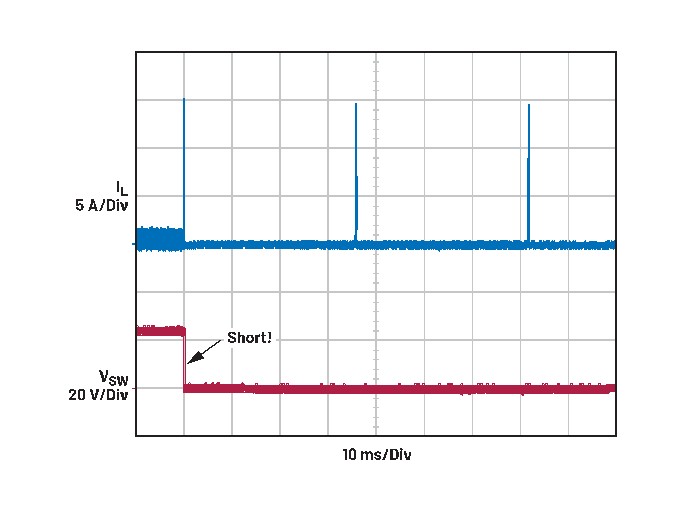
▲그림 6. 출력 단락 시 히컵 모드 동작
LT8342는 부스트 컨버터의 입력 전압이 통상적으로 제어되는 출력 전압보다 높은 차량용 프리부스트(preboost) 애플리케이션에 탁월한 선택이다. 이러한 조건이 발생할 경우, 이 IC는 패스스루(PassThru) 모드로 전환된다. IC 내부의 상단에 배치된 동기식 전원 스위치가 100% 듀티로 켜진 상태를 유지하고, 하단 스위치는 꺼진 상태를 유지함으로써 입력에서 출력으로 직접적인 경로가 생성된다. 또한 이 조건에서 LT8342는 대기 모드에 들어감으로써, 단락 보호가 활성화되지 않은 경우 12㎂를, 외부 입력 차단 FET가 작동할 때에는 26.5㎂를 소비한다. 그림 7은 스톱-스타트 및 콜드 크랭크를 위한 프리부스트 애플리케이션을 보여주며, 그림 8은 패스스루 모드가 활성화되었을 때 동작을 보여준다.
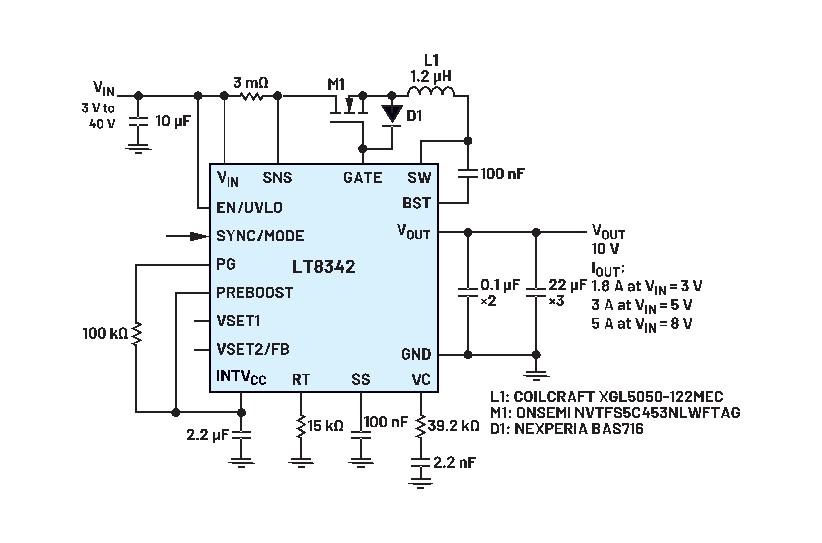
▲그림 7. 콜드 크랭크, 스톱-스타트 및 단락 보호 기능을 지원하는 10V 출력의 차량용 2㎒ 프리부스트 컨버터
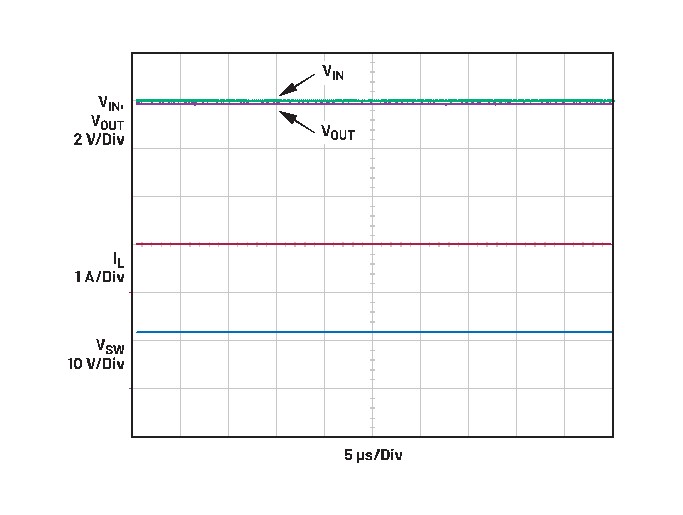
▲그림 8. 패스스루 모드 동작, VIN = 12V, ILOAD = 1A
LT8342는 소형 패키지에 저잡음, 낮은 입력 전류, 우수한 효율 및 회로 보호 기능을 포함한 다양한 기능들을 제공한다. 폭 넓은 입력 및 출력 범위, 설정 가능한 스위칭 주파수, 저잡음, 패스스루 모드를 갖춘 이 디바이스는 일반 부스트 및 차량용 프리부스트 애플리케이션에 이상적이다. 버스트 모드 동작과 낮은 입력 대기 전류는 일반 부스트 컨버터에서 제공하지 못하는 뛰어난 경부하 효율을 구현한다.
※ 저자 소개
마이클 우(Michael Wu)는 아나로그디바이스의 제품 애플리케이션 엔지니어이다. 그는 ADI의 고성능 전원(High Performance Power, HPP) 그룹에서 모놀리식 벅, 부스트, 벅-부스트 토폴로지를 담당하고 있다. 샌루이스 오비스포에 있는 캘리포니아 폴리테크닉 주립대학교에서 전기공학 석사 및 학사 학위를 받았다.
.jpg)

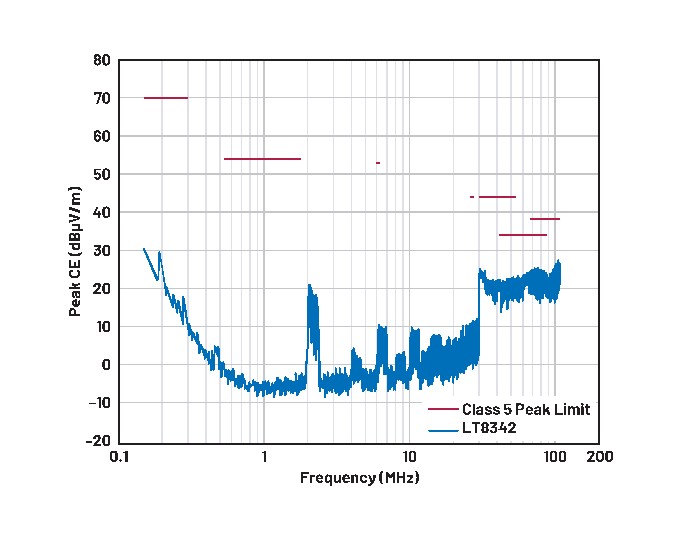
.jpg)



